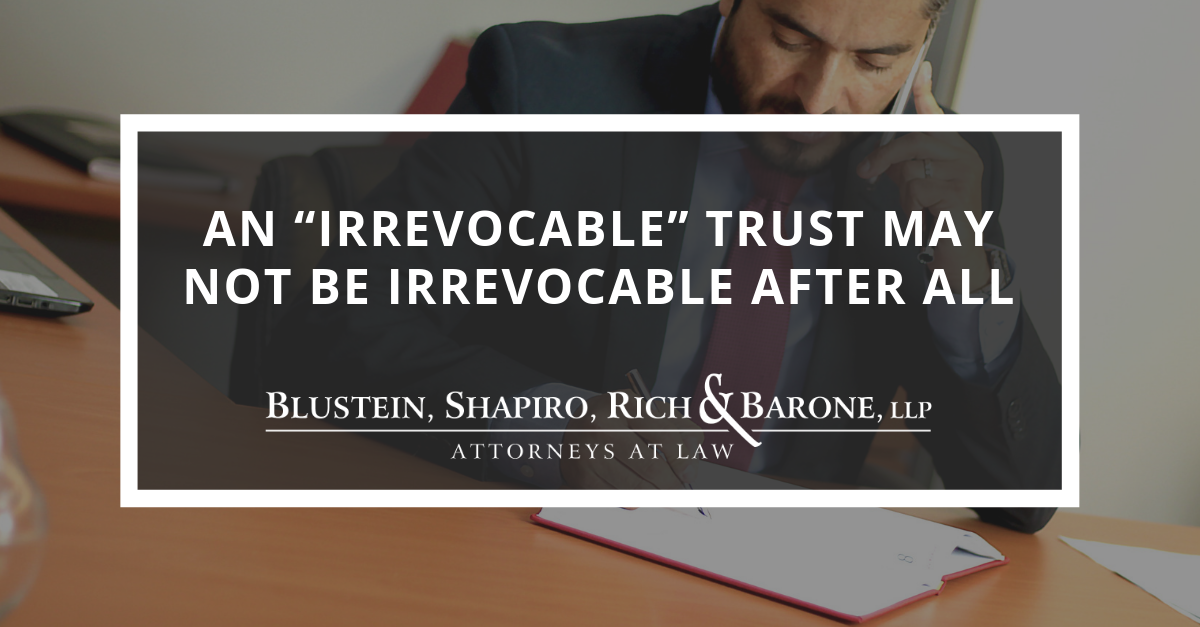
The most common client request in my elder law practice is the desire to protect a residence and other assets from the high cost of long-term care, which in the Hudson Valley will often exceed $12,000 per month. Proactive planning requires that the client make gifts of selected assets, with such asset transfers being deemed “exempt” from Medicaid consideration five years after the transfer. While such gifts may be made outright, immediate gifts will cause a complete loss of control over the assets, a loss of income derived from the gifted assets, and possible adverse income tax consequences to the children or other recipients.
An option far better than outright gifts in almost every situation is the use of an Irrevocable “Medicaid Asset Protection Trust.” Assets transferred to a properly structured Medicaid Asset Protection Trust will be “off the table” for nursing home Medicaid eligibility purposes if the person creating the trust (the “Trustmaker”) does not apply for nursing home Medicaid for at least five years after funding the trust. The trust must provide that the Trustmaker relinquishes access and control over the trust principal, but can retain rights to the trust income. While the Trustmaker is prohibited from receiving distributions of trust principal, other beneficiaries – typically children and grandchildren — are permitted beneficiaries of trust principal.
Medicaid Asset Protection Trusts have become especially popular with clients at or near retirement with a reliable income from Social Security, pensions, IRAs and other retirement accounts. Clients concerned about exposing their assets to the increasing costs of long-term care are happy to gain the protection afforded by the Medicaid Asset Protection Trust for selected assets, often including their primary residence.
For all the benefits afforded by the Medicaid Asset Protection Trust, however, clients are often understandably hesitant to do something “irrevocably.” No matter how much income they have, they often ask, “but what if I really need to get at the principal in the trust?” Or, there always remains the concern regarding a possible need for nursing home care within five years of funding the assets to the trust, which results in the trust assets being deemed “countable resources” for Medicaid purposes.
Fortunately, New York law provides a simple method of revoking even an irrevocable trust. To revoke a trust created under New York law, Section 7-1.9(a) of the Estates, Powers & Trusts Law (“EPTL”) simply requires the written consent of the Trustmaker and all the trust beneficiaries. Once the trust is revoked, the trust assets can be returned to the Trustmaker, effectively “undoing” the property transfers. Although there may be gift tax consequences for a revocation, this is rarely an issue as very few estates in which a Medicaid Asset Protection Trust is used are large enough to require the payment of gift taxes.
A practical problem arises, however, when the trust includes minor beneficiaries (typically grandchildren). Revocation under EPTL §7-1.9 cannot be utilized with minor beneficiaries, since they are legally incapable of consenting to a revocation. Fortunately, there is an easy fix for this problem. The Trustmaker may retain a lifetime “power of appointment” to remove or add additional principal beneficiaries during the Trustmaker’s lifetime. Should the need arise to terminate a trust, the Trustmaker can simply exercise the power of appointment to eliminate the minor beneficiaries from the trust, after which the trust can be revoked by the Trustmaker and the adult beneficiaries.
Another possible hurdle is the circumstance where a trust revocation is necessary because the Trustmaker has a sudden health crisis (such as a stroke), but the Trustmaker is incapable of consenting to the revocation. This problem is easily solved by including in both the trust and in the Trustmaker’s Durable General Power of Attorney a provision authorizing the agent under the Power of Attorney to terminate any trusts created by the Trustmaker. This technique was approved by a New York appellate court in Matter of Perosi v. LiGreci. In that 2012 case, the court held that a Trustmaker may authorize an attorney-in-fact designated under the Trustmaker’s power of attorney to act under EPTL §7-1.9 to amend or revoke the Trustmaker’s irrevocable trust under, so long as the power of attorney grants the attorney-in-fact the power broad general authority to act.
By virtue of New York’s powerful revocation powers, using a Medicaid Asset Protection Trust provides seniors with a wonderful vehicle of protecting selected assets, while retaining the right to income from the assets, and significant control over the disposition of the trust principal. The ability to retain such benefits, however, requires coordinated planning best provided by an elder law attorney well versed in this planning technique.
Richard J. Shapiro is a partner with the Hudson Valley law firm of Blustein, Shapiro, Frank & Barone, LLP. He is the author of the 2017 book Secure Your Legacy: Estate Planning and Elder Law for Today’s American Family published by Archway Publishing. Mr. Shapiro, who is “AV” rated by Martindale-Hubbell and named a “Super Lawyer” in Estate Planning and Probate law, is a member of WealthCounsel, ElderCounsel, the National Academy of Elder Law Attorneys, the New York State Bar Association (Trusts and Estates and Elder Law Sections), and the Hudson Valley Estate Planning Council. You can reach him at (845) 291-0011 or at rshapiro@mid-hudsonlaw.com. The information in this article is for general information only and is not, nor is it intended to be, legal advice.
